[ad_1]
As the outsized environmental impact of superyachts comes under increasing scrutiny, Nat Barker explores how the industry is responding.
Luxury yacht festivals are changing. Delegates descending on shows in Cannes, Monaco and Fort Lauderdale in the past two months will have struggled to miss the proliferation of programme items intended to highlight exhibitors presenting “sustainable” solutions for the industry.
The initiatives are a response to increasing criticisms of yachting’s impact on the environment in recent years.
“Just about the most environmentally irresponsible thing one human can do”
Along with private jets, superyachts – defined as yachts at least 24 metres in length – are one of the most obvious symptoms of ultra-consumption among the very rich, which has become a rising concern for some climate campaigners.
“Owning a superyacht is just about the most environmentally irresponsible thing one human being can do,” said Chris Armstrong, a professor of political theory at the University of Southampton and author of A Blue New Deal: Why We Need a New Politics for the Ocean.
Superyacht figures often bristle at the focus their industry is getting, arguing its overall impact is tiny.
Last year’s Monaco Yacht Show was explicitly oriented around environmental issues, but the event’s opening conference made sure “to dispel prejudices regarding yachting’s impact on global marine pollution, which stands at 0.3 per cent”, according to an official press release.
“We are – I wouldn’t say irrelevant – but we don’t play the big part of the bad guy, or the good guy,” Alberto Galassi, CEO of major yacht builder Ferretti Group, told Dezeen in Cannes.
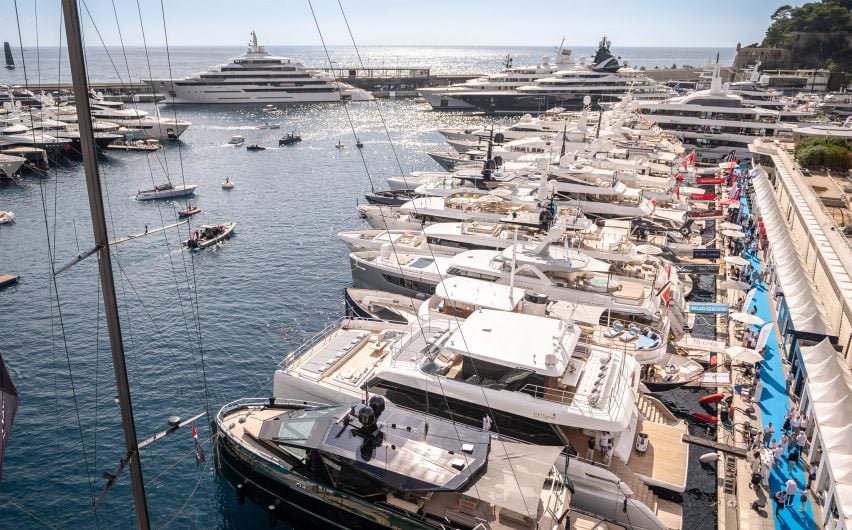
Despite its relatively small size compared to, say, the cruise industry, the superyacht industry is growing rapidly following a major boom during the pandemic.
Nearly 6,000 superyachts are now estimated to float on the world’s waters, up from less than 2,000 at the turn of the millennium and less than 1,000 in the late 1980s. The market size is projected to roughly double in the coming decade.
And the environmental impact of each of these vessels is enormous. Spanish yacht refitting company MB92 Group estimated that a superyacht can generate up to 7,020 tonnes of CO2 a year – more than 1,500 times that of a typical family car.
According to Grégory Salle’s book Superyachts: Luxury, Tranquility and Ecocide, the combined emissions of the 300 largest superyachts in frequent use is greater than Burundi’s 13 million people.
Nevertheless, virtually every new superyacht to hit the seas is marketed as a step forwards for sustainability – a habit that has given rise to accusations of greenwashing, from Salle, Armstrong and others.
“Messages are nicely groomed”
Even Galassi, who is proud that Ferretti Group was the first company in the industry to begin publishing sustainability reports in 2019, appeared to suggest this is an issue.
“I hate when people are talking about ‘bla, bla, bla’ bullshit – what have you really done? he said. “What have you really done, not pushed by the law to do it?”
“In a strong marketing-driven industry, messages are nicely groomed, and often the factual supporting information is missing,” echoed Giedo Loeff, head of research and development at Dutch yacht yard Feadship.
“So the gains cannot be rated, nor justification can be found,” he added. “I do believe the publications may be sincere, but it is quite simply not possible to judge.”
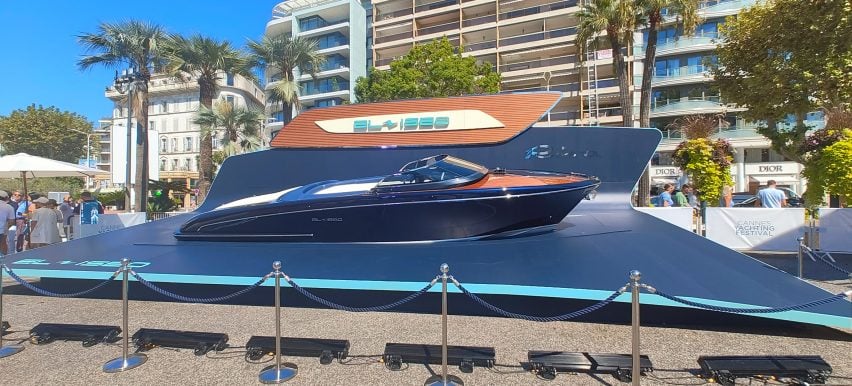
Fuel is the major issue. According to Loeff, burning fossil fuels accounts for well over 90 per cent of a superyacht’s total global warming potential contribution.
Electrification has become the alternative propulsion-method of choice for the automotive industry.
The technology has started to take off in the powerboat class – with Ferretti’s Riva El-Iseo proudly displayed at the main entrance to Cannes Yachting Festival in September – but it is unlikely to be practical in superyachts.
“Batteries are not for large vessels, I don’t see that,” said Galassi. “You’d need a chase boat with batteries.”
Instead, hybrid engines are becoming more common, while some yacht builders are now investing in adopting green methanol, a liquid fuel produced from burning agricultural or municipal waste.
According to the methanol industry, green methanol can reduce carbon dioxide emissions by 60 to 95 per cent compared with conventional fuels – although it is also costly, highly flammable and requires much more storage space.
In May, Italian manufacturer Sanlorenzo unveiled 50Steel – the first superyacht to use a reformer fuel cell system that converts green methanol into hydrogen to power the ship’s onboard systems, or hotel, without producing carbon dioxide.
Sanlorenzo also recently launched the Life Mystic project to build the first bi-fuel superyacht powered by a combination of green methanol and diesel by 2027, with 60 per cent of the funding provided by the European Union (EU).
Feadship, which like Sanlorenzo has set itself a target to produce a carbon-neutral superyacht by 2030, is additionally experimenting with liquid hydrogen, launching the first fuel-cell-powered superyacht, Project 821, in May.
Hydrogen requires 30 times more storage space than diesel, meaning that even at almost 119 metres in length, Project 821’s range is restricted by the amount of fuel it can carry.
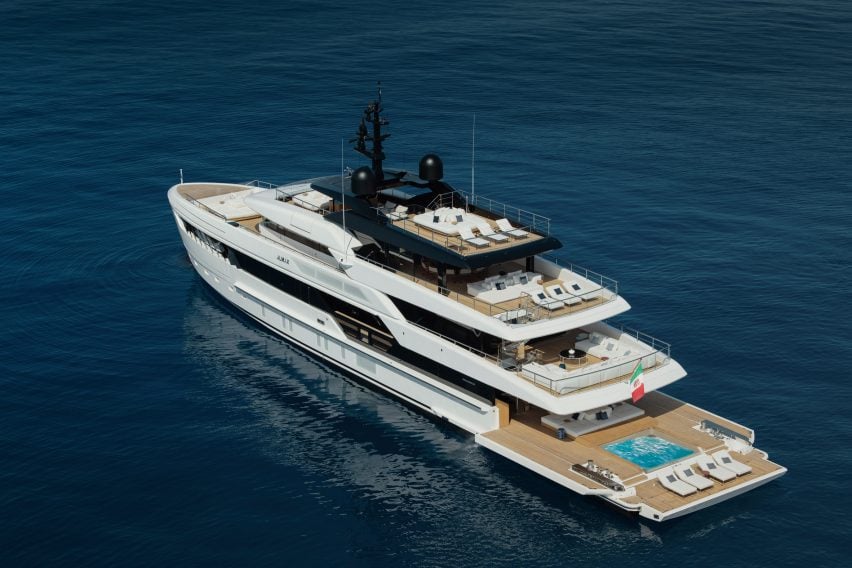
As a result, Loeff believes pure hydrogen is unlikely to trump methanol and other synthetic liquid fuels for superyachts.
“Pure hydrogen will have its applications on various ship types, like inland shipping and short-sea routes like a Norwegian ferry,” he explained.
“But for the vast majority hydrogen will be produced from renewable sources and synthesised to other ‘carriers’ like ammonia, methanol and more complex hydrocarbons.”
Loeff points out that as well as developing new fuel technologies, efficiency remains a significant issue for superyachts, which are incredibly energy-hungry.
Some yacht designers have started to prioritise narrower shapes that allow vessels to cut more smoothly through the water, or use aluminium to build a lighter hull.
Converting shipping containers into megayachts
Material use is a significant contributor to a superyacht’s life-cycle environmental footprint, with the largest vessels using around 1,500 tonnes of steel.
Italian yacht designer Mario Biferali has attempted to explore how wealthy clients’ continuing desire for enormous ships could be married with a less resource-intensive approach.
In collaboration with Dutch yard Oceanco at last month’s Monaco Yacht Show, he presented his Nacht concept for converting a decommissioned container ship into a 150-metre megayacht.
“I thought about what has happened in architecture – we want to start using existing things and not creating something new,” Biferali told Dezeen.
“So why not use the same approach in the yachting industry? Instead of scrapping those large vessels along the shores of Bangladesh, Pakistan, Turkey, we give them a new identity, a new life.”
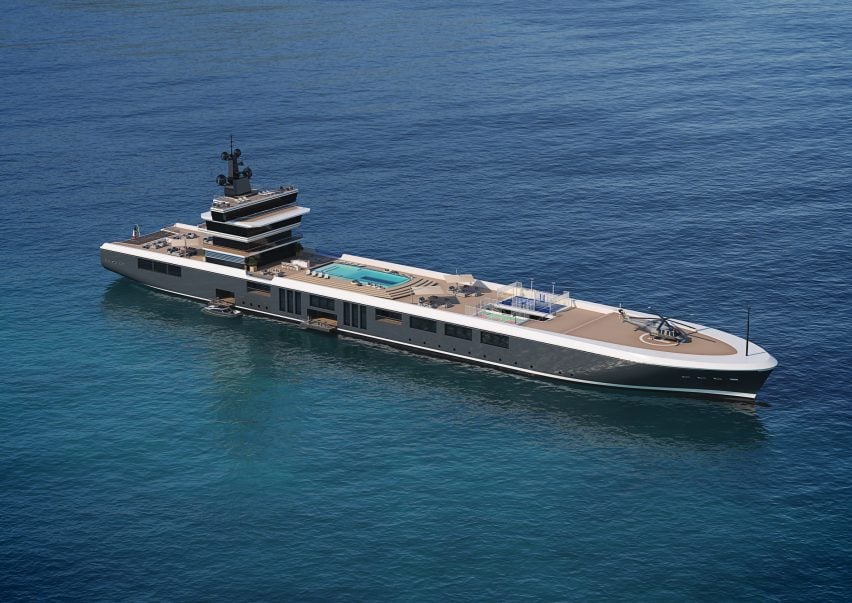
By combining extreme size with less use of virgin materials, Biferali’s project also tries to confront a key issue: how to encourage prospective superyacht buyers to value more sustainable approaches.
Ultimately, he argues, this is the factor that will drive change – particularly since made-to-measure superyachts are where the industry really makes its money.
“Why do we see these crazy superyachts nowadays? he said. “We see them because a client has challenged us with a groundbreaking vessel and out of the box requests.”
“We need the motivation to go and look beyond our boundaries,” he continued. “But above all, we need investment and funds to support the industry to explore stronger ecological solutions with lower carbon footprint.”
“Hardly any regulations”
Galassi insists that superyacht buyers do care – though whether they care enough to pay substantially more for a less polluting boat is another question.
“Any yachting person that I know respects the sea more than you can imagine,” he said. “So the clients are happy that we are in that direction.”
“Are they buying a boat of this instead of the other one because of some [sustainability] solutions? Not too much, because some of the solutions could be very expensive. So the percentage is maybe one over 10, one over 20, but you must have the offering.”
And if superyacht owners want to spend money on assuaging guilt they may feel about their hobby, they have other options.
For instance, a specialist carbon offset company promises to “counterbalance the unavoidable greenhouse gas impact of your yachting activity today whilst preserving your cruising freedom”.
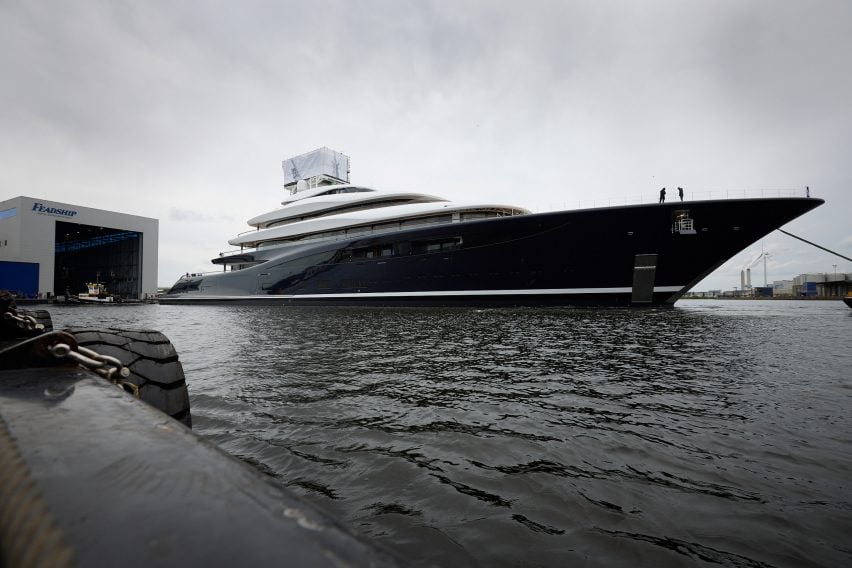
Another possible route to decarbonising the superyacht industry could be enhanced regulation.
Rules intended to limit maritime emissions are overwhelmingly focused on the biggest vessels such as oil tankers, so there are currently very few requirements on superyachts.
“The superyacht fleet has hardly any regulations to comply to at the moment,” said Loeff. “There is no fuel reporting, efficiency indexation and alignment with the alternative fuel regulations [or] pricing schemes.”
Nevertheless, according to Salle’s book the International Council of Marine Industry Associations, which represents the recreational boating industry, previously successfully lobbied the EU to allow shipyards to continue to police their own emissions from paints and solvents.
“It cannot be ecological”
Within that context, reducing the environmental impact of superyachts is currently mainly a matter of conscience for those at the top of the industry.
“It is a moral duty which, in my opinion, is more important than any regulation,” said Galassi. “Nobody’s pushing the gun in our heads, it’s just that we have to do it, we want to do it.”
Organisations such as the Water Revolution Foundation, established in 2018, are attempting to accelerate the change.
“A yacht is a yacht,” concluded Biferali. “It cannot be ecological, because you don’t need a 100-metre yacht for your 12 friends.”
“So we are conscious of what we are building and what we are designing, but we do our best to care about the environment.”
But for some, like Armstrong, it’s the superyacht industry’s very existence that’s the issue.
“The fact remains that, when we take their whole life-cycles into account, the resources involved in building and running a superyacht are enormous, and unjustifiable in the kind of world we live in,” he argued.
“The sooner all superyachts are decommissioned, the better.”
Dezeen In Depth
If you enjoy reading Dezeen’s interviews, opinions and features, subscribe to Dezeen In Depth. Sent on the last Friday of each month, this newsletter provides a single place to read about the design and architecture stories behind the headlines.
[ad_2]
Source link

